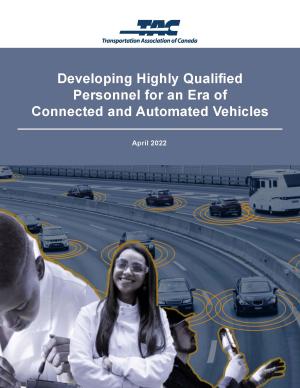A new Transportation Association of Canada (TAC) publication on developing highly qualified personnel to meet industry demands as transportation becomes more technologically advanced is now available.
 New transportation technologies such as connected and automated vehicles promise to improve safety, reduce congestion, increase accessibility, and reduce emissions. To capitalize on these opportunities, road authorities will need to develop a suitable body of highly qualified personnel (HQP) who offer skillsets in areas such as cybersecurity, data science, computer programming and analytics that lie outside traditional transportation engineering.
New transportation technologies such as connected and automated vehicles promise to improve safety, reduce congestion, increase accessibility, and reduce emissions. To capitalize on these opportunities, road authorities will need to develop a suitable body of highly qualified personnel (HQP) who offer skillsets in areas such as cybersecurity, data science, computer programming and analytics that lie outside traditional transportation engineering.
Developing Highly Qualified Personnel for an Era of Connected and Automated Vehicles identifies key trends in technology and mobility over the coming 20 years, suggests skillsets that road authorities will need to develop, examines current measures to educate and train HQP in Canada, inventories key gaps, and recommends a comprehensive action plan. It is currently available in English in TAC’s online catalogue as a free PDF. The French version is expected to be released later in 2022.
“Canadian road authorities looking to fast-track their progress toward vision zero need a workforce that can make the best use of CAV technologies. They will find excellent guidance in this report.”
|
The report will be of interest to a wide variety of organizations including road authorities, post-secondary institutions and instructors, professional and engineering licensing bodies, workforce development agencies, research bodies, and private companies.
It presents the results of a thorough literature review and engagement with four stakeholder groups (road authorities, academics, professional associations, and the technology industry) and provides a gap analysis including key challenges and opportunities, and a series of recommended actions over five-, 10- and 20-year horizons. The action plan focuses on educating the future transportation workforce, training the existing transportation workforce, and improving human resources practices and agency governance.
“Transportation agencies will have to plan, manage, and operate in a future with disruptive technologies. This study can help them develop the human capital they require to meet that challenge.”
|
The project to develop the report was conducted by MORR Transportation Consulting and guided by seven TAC member organizations that funded the work:
For details and to download Developing Highly Qualified Personnel for an Era of Connected and Automated Vehicles, visit PTM-DHQP-E | tac-atc.ca.
Contact us for more information.